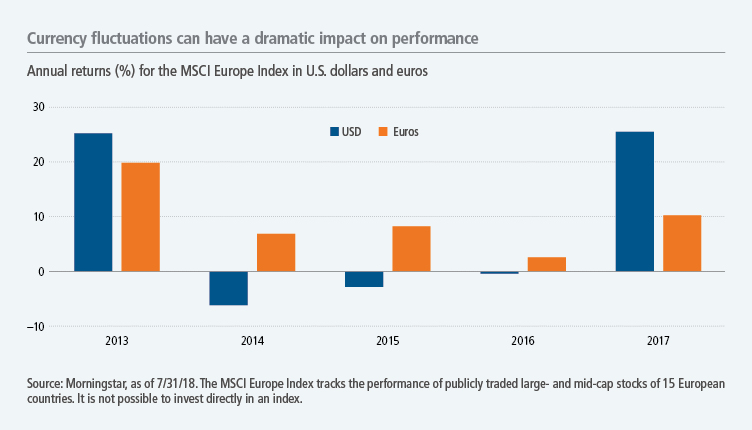How to value a currency: a closer look at the opportunities in FX markets
It’s been often observed how truly global the financial markets have become and how easily capital today flows between different countries and regions in search of opportunities.

But the role currency fluctuations can play when it comes to performance is sometimes an underappreciated risk—and an opportunity—that comes with investing globally.
Investors have, ultimately, three options when it comes to navigating the currency risk in global investments. The first is to opt out of it by holding only investments denominated in U.S. dollars (USD). Many foreign bonds, especially in emerging markets, are issued in USD; equity investors, meanwhile, can often purchase American depositary receipts for foreign companies’ stocks, which trade on U.S. stock exchanges, naturally, in dollars. The second option is to attempt to hedge currency risk away, which is typically achieved through the use of currency futures and options. Implementing those safeguards against foreign exchange risk has a cost, but the result is that currency fluctuations won’t influence a foreign investment’s total return, for better or worse. The third option—and the one we pursue—is to actively manage currency exposure, tailoring it independently of the underlying investment.
Case study: how failing to manage currency exposure can turn a gain into a loss
To illustrate how vital it is to manage currency exposure, consider the performance of the MSCI Europe Index, a portfolio of some of the biggest stocks on the Continent. Over the past five years, the index—when looking at the returns in euros—has posted a gain every single year. But when those returns are converted into U.S. dollars, the index actually lost ground in three of the past five years. What’s more, in 2014, 2015, and 2017, the difference in performance between euros and USD was 10% or more. Needless to say, that’s a huge swing and it underscores that establishing a view on currency is just as important as having a view on the underlying investment.

What are the factors in valuing a currency?
The first step in deciding whether to invest in a currency is to try and gauge its future trajectory—whether it’s likely to strengthen or weaken going forward. One of the more challenging aspects of this work is that currencies have no absolute values—they can only fluctuate in value relative to other currencies. But what factors actually cause a currency’s value to fluctuate in the first place?
- Interest rate differentials. Countries with higher interest rates than their peers tend to have stronger currencies, particularly when the gap is widening. This intuitively makes sense, as the return on cash in high interest-paying countries is more attractive than in low interest-paying countries, and capital flows tend to highlight this discrepancy.
- Central bank policy. When a country’s central bank is cutting rates, that’s almost always indicative of a problem, usually a big economic slowdown or financial turmoil. But when a central bank is raising rates, that’s usually a sign of a strong economy—and a strengthening currency. Trying to anticipate a central bank’s policy, at least directionally, is vital to assessing a currency’s trajectory.
- Geopolitical risks. Elections, recessions, wars—any number of geopolitical factors can intervene to influence an economy and a currency’s trajectory. Today in the United States, tariffs and trade disputes are being watched closely—ostensibly, one of the desired effects of the Trump administration seems to be a weaker USD, but to date that hasn’t been the case. At any rate, assessing the likelihood of destabilizing geopolitical events is another important leg in gauging a currency’s relative worth.
As an investor, once you’ve established a directional view on a currency, the only way to implement that view is through establishing an offsetting position in another currency. In practice, that often means taking a long or bullish position in the currency you believe looks most likely to strengthen (say, for example, USD) and establishing a short or bearish position in a currency that appears poised to weaken (again, for example, the euro). If, over time, one dollar goes on to buy more euros on the foreign exchange market, that hypothetical investment would be a profitable one.
Active currency management can be a great source of uncorrelated alpha
The bottom line is that managing currency risk is an indispensable part of international investing and establishing independent views on currencies can be a meaningful source of alpha. Historically, it’s been relatively rare for the USD and other major currencies to move in lockstep. Currencies tend to be volatile and to move independently, which creates a landscape that’s constantly offering new investment opportunities for managers that know how to take advantage of them.
Important disclosures
Important disclosures
The views expressed are those of the author(s) and are subject to change. No forecasts are guaranteed. This commentary is provided for informational purposes only and is not an endorsement of any security, mutual fund, sector, or index.
Foreign investing, especially in emerging markets, has additional risks, such as currency and market volatility and political and social instability. Currency transactions are affected by fluctuations in exchange rates. Liquidity—the extent to which a security may be sold or a derivative position closed without negatively affecting its market value, if at all—may be impaired by reduced trading volume, heightened volatility, rising interest rates, and other market conditions.
MF561668






